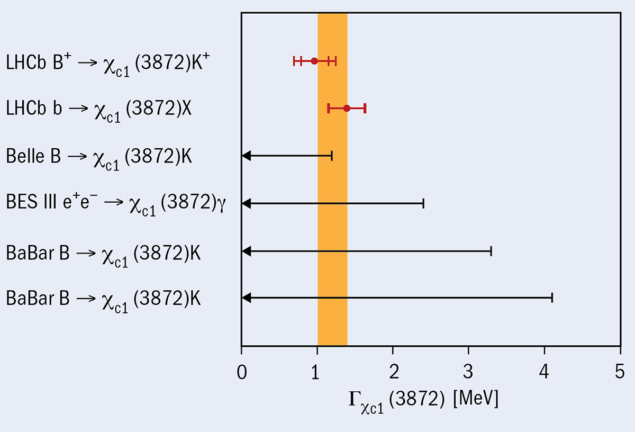A report from the LHCb experiment

In 2003, the Belle collaboration reported the discovery of a mysterious new hadron, the X(3872), in the decay B+→X(3872)K+. Their analysis suggested an extremely small width, consistent with zero, and a mass remarkably close to the sum of the masses of the D0 and D*0 mesons. The particle’s existence was later confirmed by the CDF, D0, and BaBar experiments. LHCb first reported studies of the X(3872) in the data sample taken in 2010, and later unambiguously determined its quantum numbers to be 1++, leading the Particle Data Group to change the name of the particle to χc1(3872).
The nature of this state is still unclear. Until now, only an upper limit on the width of the χc1(3872) of 1.2 MeV has been available. No conventional hadron is expected to have such a narrow width in this part of the otherwise very well understood charmonium spectrum. Among the possible explanations are that it is a tetraquark, a molecular state, a hybrid state where the gluon field contributes to its quantum numbers, or a glueball without any valence quarks at all. A mixture of these explanations is also possible.
Two new measurements
As reported at the LHCP conference this week, the LHCb collaboration has now published two new measurements of the width of the χc1(3872), based on minimally overlapping data sets. The first uses Run 1 data corresponding to an integrated luminosity of 3 fb-1, in which (15.5±0.4)×103 χc1(3872) particles were selected inclusively from the decays of hadrons containing b quarks. The second analysis selected (4.23±0.07)×103 fully reconstructed B+→χc1(3872)K+ decays from the full Run 1–2 data set, which corresponds to an integrated luminosity of 9 fb-1. In both cases, the χc1(3872) particles were reconstructed through decays to the final state J/ψπ+π−. For the first time the measured Breit-Wigner width was found to be non-zero, with a value close to the previous upper limit from Belle (see figure).
Combining the two analyses, the mass of the χc1(3872) was found to be 3871.64±0.06 MeV – just 70±120 keV below the D0D*0 threshold. The proximity of the χc1(3872) to this threshold puts a question mark on measuring the width using a simple fit to the well-known Breit-Wigner function, as this approach neglects potential distortions. Conversely, a precise measurement of the line-shape could help elucidate the nature of the χc1(3872). This has led LHCb to explore a more sophisticated Flatté parametrisation and report a measurement of the χc1(3872) line-shape with this model, including the pole positions of the complex amplitude. The results favour the interpretation of the state as a quasi-bound D0D*0 molecule, but other possibilities cannot yet be ruled out. Further studies are ongoing. Physicists from other collaborations are also keenly interested in the nature of the χc1(3872), and the very recent observation by CMS of the decay process Bs0→χc1(3872)? suggests another laboratory for studying its properties.








